Women Above The Glass Ceiling
VerifiedAdded on 2023/01/20
|18
|5363
|59
AI Summary
This paper explores the perceptions of women on strategies and mobility for success in top positions. It analyzes how women strategically raise their social capital to excel in male-dominated networks.
Contribute Materials
Your contribution can guide someone’s learning journey. Share your
documents today.

Women Above The Glass Ceiling 1
WOMEN ABOVE THE GLASS CEILING
By (Student’s Name)
Professor’s Name
College
Course
Date
WOMEN ABOVE THE GLASS CEILING
By (Student’s Name)
Professor’s Name
College
Course
Date
Secure Best Marks with AI Grader
Need help grading? Try our AI Grader for instant feedback on your assignments.
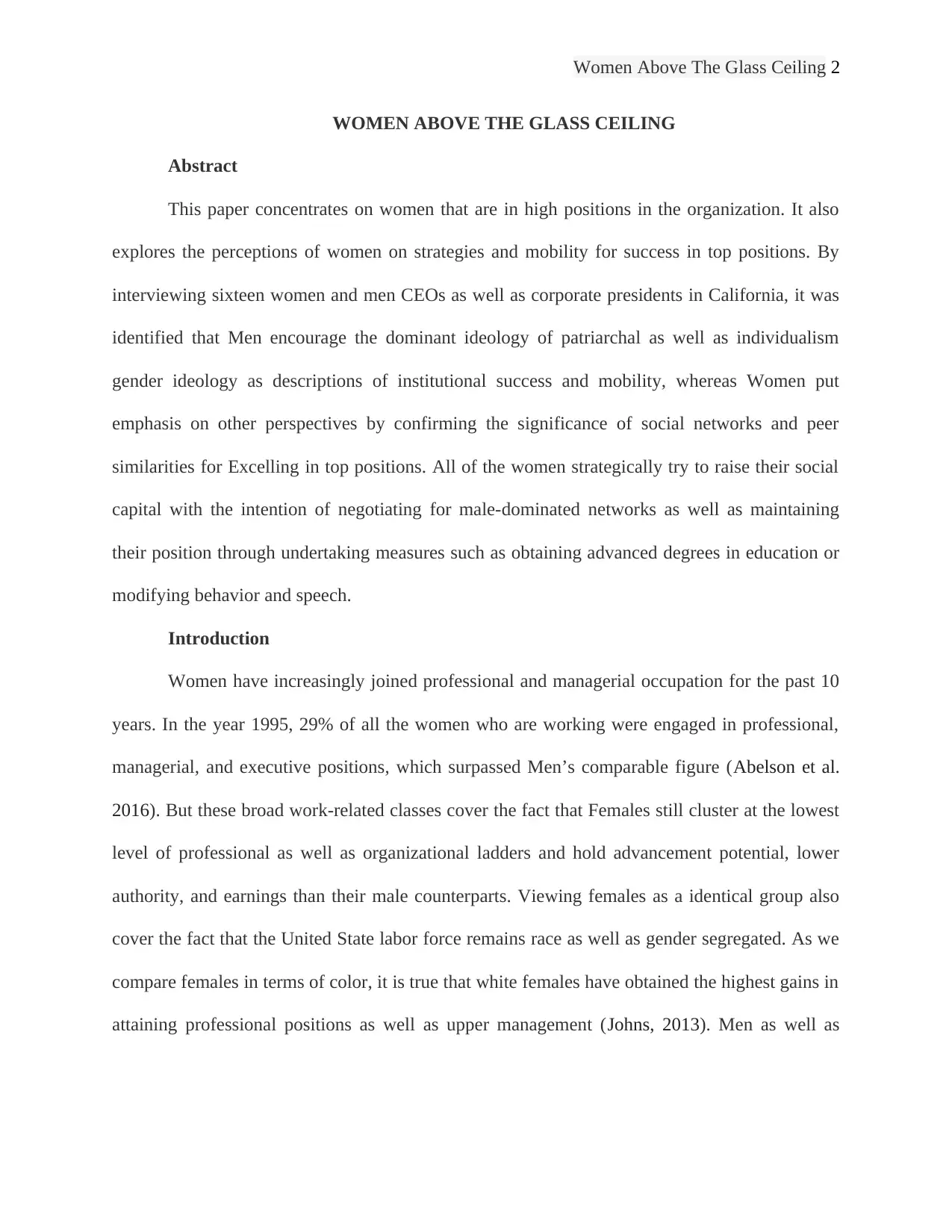
Women Above The Glass Ceiling 2
WOMEN ABOVE THE GLASS CEILING
Abstract
This paper concentrates on women that are in high positions in the organization. It also
explores the perceptions of women on strategies and mobility for success in top positions. By
interviewing sixteen women and men CEOs as well as corporate presidents in California, it was
identified that Men encourage the dominant ideology of patriarchal as well as individualism
gender ideology as descriptions of institutional success and mobility, whereas Women put
emphasis on other perspectives by confirming the significance of social networks and peer
similarities for Excelling in top positions. All of the women strategically try to raise their social
capital with the intention of negotiating for male-dominated networks as well as maintaining
their position through undertaking measures such as obtaining advanced degrees in education or
modifying behavior and speech.
Introduction
Women have increasingly joined professional and managerial occupation for the past 10
years. In the year 1995, 29% of all the women who are working were engaged in professional,
managerial, and executive positions, which surpassed Men’s comparable figure (Abelson et al.
2016). But these broad work-related classes cover the fact that Females still cluster at the lowest
level of professional as well as organizational ladders and hold advancement potential, lower
authority, and earnings than their male counterparts. Viewing females as a identical group also
cover the fact that the United State labor force remains race as well as gender segregated. As we
compare females in terms of color, it is true that white females have obtained the highest gains in
attaining professional positions as well as upper management (Johns, 2013). Men as well as
WOMEN ABOVE THE GLASS CEILING
Abstract
This paper concentrates on women that are in high positions in the organization. It also
explores the perceptions of women on strategies and mobility for success in top positions. By
interviewing sixteen women and men CEOs as well as corporate presidents in California, it was
identified that Men encourage the dominant ideology of patriarchal as well as individualism
gender ideology as descriptions of institutional success and mobility, whereas Women put
emphasis on other perspectives by confirming the significance of social networks and peer
similarities for Excelling in top positions. All of the women strategically try to raise their social
capital with the intention of negotiating for male-dominated networks as well as maintaining
their position through undertaking measures such as obtaining advanced degrees in education or
modifying behavior and speech.
Introduction
Women have increasingly joined professional and managerial occupation for the past 10
years. In the year 1995, 29% of all the women who are working were engaged in professional,
managerial, and executive positions, which surpassed Men’s comparable figure (Abelson et al.
2016). But these broad work-related classes cover the fact that Females still cluster at the lowest
level of professional as well as organizational ladders and hold advancement potential, lower
authority, and earnings than their male counterparts. Viewing females as a identical group also
cover the fact that the United State labor force remains race as well as gender segregated. As we
compare females in terms of color, it is true that white females have obtained the highest gains in
attaining professional positions as well as upper management (Johns, 2013). Men as well as
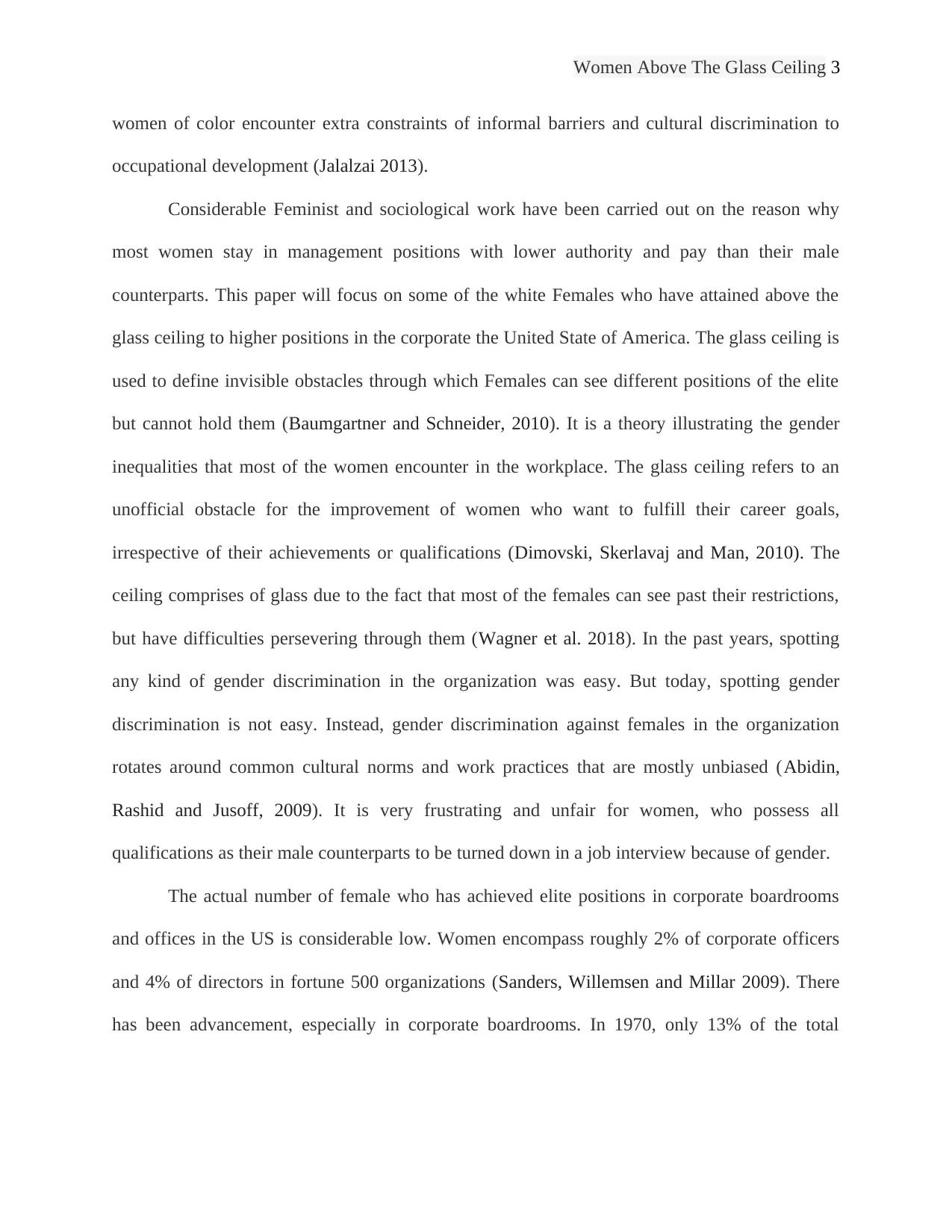
Women Above The Glass Ceiling 3
women of color encounter extra constraints of informal barriers and cultural discrimination to
occupational development (Jalalzai 2013).
Considerable Feminist and sociological work have been carried out on the reason why
most women stay in management positions with lower authority and pay than their male
counterparts. This paper will focus on some of the white Females who have attained above the
glass ceiling to higher positions in the corporate the United State of America. The glass ceiling is
used to define invisible obstacles through which Females can see different positions of the elite
but cannot hold them (Baumgartner and Schneider, 2010). It is a theory illustrating the gender
inequalities that most of the women encounter in the workplace. The glass ceiling refers to an
unofficial obstacle for the improvement of women who want to fulfill their career goals,
irrespective of their achievements or qualifications (Dimovski, Skerlavaj and Man, 2010). The
ceiling comprises of glass due to the fact that most of the females can see past their restrictions,
but have difficulties persevering through them (Wagner et al. 2018). In the past years, spotting
any kind of gender discrimination in the organization was easy. But today, spotting gender
discrimination is not easy. Instead, gender discrimination against females in the organization
rotates around common cultural norms and work practices that are mostly unbiased (Abidin,
Rashid and Jusoff, 2009). It is very frustrating and unfair for women, who possess all
qualifications as their male counterparts to be turned down in a job interview because of gender.
The actual number of female who has achieved elite positions in corporate boardrooms
and offices in the US is considerable low. Women encompass roughly 2% of corporate officers
and 4% of directors in fortune 500 organizations (Sanders, Willemsen and Millar 2009). There
has been advancement, especially in corporate boardrooms. In 1970, only 13% of the total
women of color encounter extra constraints of informal barriers and cultural discrimination to
occupational development (Jalalzai 2013).
Considerable Feminist and sociological work have been carried out on the reason why
most women stay in management positions with lower authority and pay than their male
counterparts. This paper will focus on some of the white Females who have attained above the
glass ceiling to higher positions in the corporate the United State of America. The glass ceiling is
used to define invisible obstacles through which Females can see different positions of the elite
but cannot hold them (Baumgartner and Schneider, 2010). It is a theory illustrating the gender
inequalities that most of the women encounter in the workplace. The glass ceiling refers to an
unofficial obstacle for the improvement of women who want to fulfill their career goals,
irrespective of their achievements or qualifications (Dimovski, Skerlavaj and Man, 2010). The
ceiling comprises of glass due to the fact that most of the females can see past their restrictions,
but have difficulties persevering through them (Wagner et al. 2018). In the past years, spotting
any kind of gender discrimination in the organization was easy. But today, spotting gender
discrimination is not easy. Instead, gender discrimination against females in the organization
rotates around common cultural norms and work practices that are mostly unbiased (Abidin,
Rashid and Jusoff, 2009). It is very frustrating and unfair for women, who possess all
qualifications as their male counterparts to be turned down in a job interview because of gender.
The actual number of female who has achieved elite positions in corporate boardrooms
and offices in the US is considerable low. Women encompass roughly 2% of corporate officers
and 4% of directors in fortune 500 organizations (Sanders, Willemsen and Millar 2009). There
has been advancement, especially in corporate boardrooms. In 1970, only 13% of the total
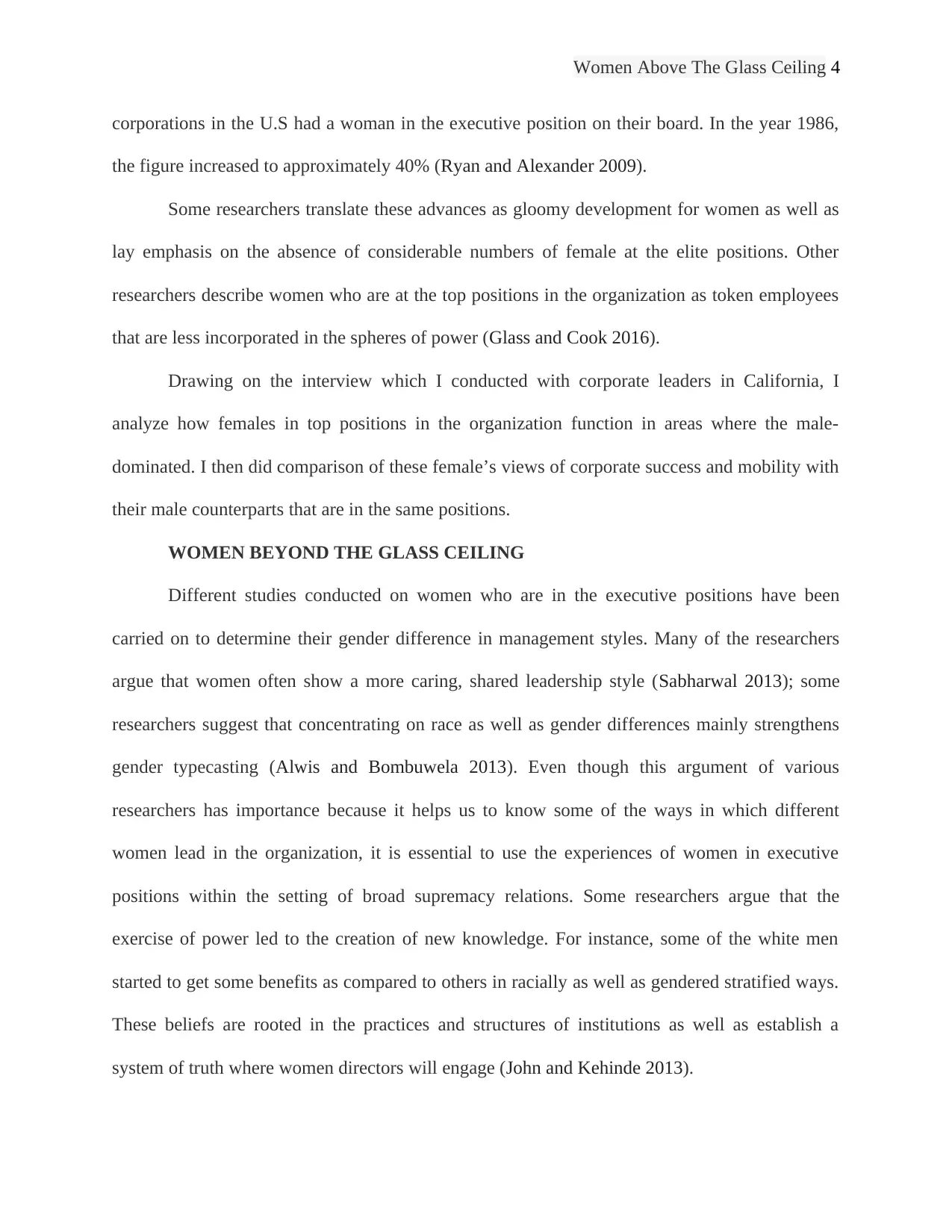
Women Above The Glass Ceiling 4
corporations in the U.S had a woman in the executive position on their board. In the year 1986,
the figure increased to approximately 40% (Ryan and Alexander 2009).
Some researchers translate these advances as gloomy development for women as well as
lay emphasis on the absence of considerable numbers of female at the elite positions. Other
researchers describe women who are at the top positions in the organization as token employees
that are less incorporated in the spheres of power (Glass and Cook 2016).
Drawing on the interview which I conducted with corporate leaders in California, I
analyze how females in top positions in the organization function in areas where the male-
dominated. I then did comparison of these female’s views of corporate success and mobility with
their male counterparts that are in the same positions.
WOMEN BEYOND THE GLASS CEILING
Different studies conducted on women who are in the executive positions have been
carried on to determine their gender difference in management styles. Many of the researchers
argue that women often show a more caring, shared leadership style (Sabharwal 2013); some
researchers suggest that concentrating on race as well as gender differences mainly strengthens
gender typecasting (Alwis and Bombuwela 2013). Even though this argument of various
researchers has importance because it helps us to know some of the ways in which different
women lead in the organization, it is essential to use the experiences of women in executive
positions within the setting of broad supremacy relations. Some researchers argue that the
exercise of power led to the creation of new knowledge. For instance, some of the white men
started to get some benefits as compared to others in racially as well as gendered stratified ways.
These beliefs are rooted in the practices and structures of institutions as well as establish a
system of truth where women directors will engage (John and Kehinde 2013).
corporations in the U.S had a woman in the executive position on their board. In the year 1986,
the figure increased to approximately 40% (Ryan and Alexander 2009).
Some researchers translate these advances as gloomy development for women as well as
lay emphasis on the absence of considerable numbers of female at the elite positions. Other
researchers describe women who are at the top positions in the organization as token employees
that are less incorporated in the spheres of power (Glass and Cook 2016).
Drawing on the interview which I conducted with corporate leaders in California, I
analyze how females in top positions in the organization function in areas where the male-
dominated. I then did comparison of these female’s views of corporate success and mobility with
their male counterparts that are in the same positions.
WOMEN BEYOND THE GLASS CEILING
Different studies conducted on women who are in the executive positions have been
carried on to determine their gender difference in management styles. Many of the researchers
argue that women often show a more caring, shared leadership style (Sabharwal 2013); some
researchers suggest that concentrating on race as well as gender differences mainly strengthens
gender typecasting (Alwis and Bombuwela 2013). Even though this argument of various
researchers has importance because it helps us to know some of the ways in which different
women lead in the organization, it is essential to use the experiences of women in executive
positions within the setting of broad supremacy relations. Some researchers argue that the
exercise of power led to the creation of new knowledge. For instance, some of the white men
started to get some benefits as compared to others in racially as well as gendered stratified ways.
These beliefs are rooted in the practices and structures of institutions as well as establish a
system of truth where women directors will engage (John and Kehinde 2013).
Secure Best Marks with AI Grader
Need help grading? Try our AI Grader for instant feedback on your assignments.
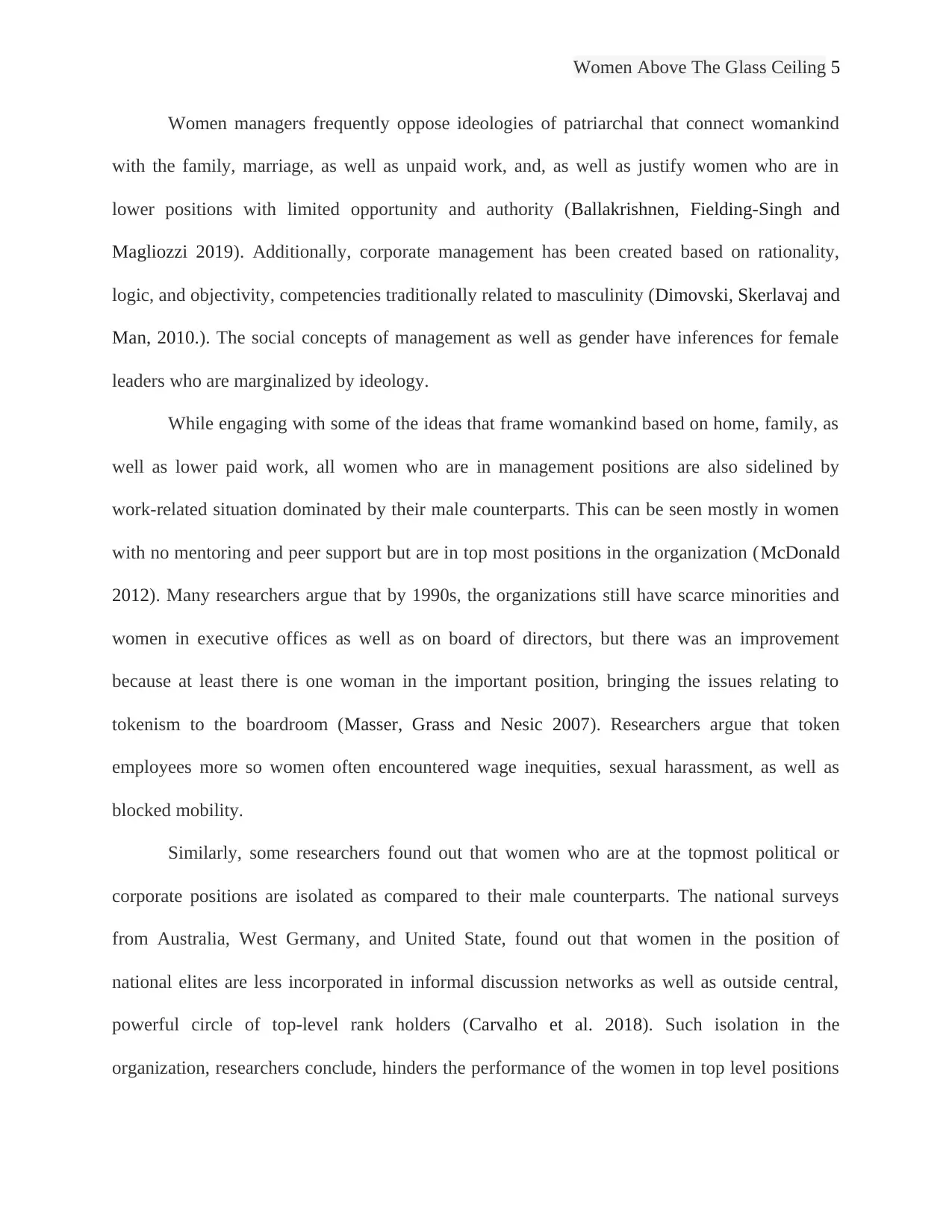
Women Above The Glass Ceiling 5
Women managers frequently oppose ideologies of patriarchal that connect womankind
with the family, marriage, as well as unpaid work, and, as well as justify women who are in
lower positions with limited opportunity and authority (Ballakrishnen, Fielding-Singh and
Magliozzi 2019). Additionally, corporate management has been created based on rationality,
logic, and objectivity, competencies traditionally related to masculinity (Dimovski, Skerlavaj and
Man, 2010.). The social concepts of management as well as gender have inferences for female
leaders who are marginalized by ideology.
While engaging with some of the ideas that frame womankind based on home, family, as
well as lower paid work, all women who are in management positions are also sidelined by
work-related situation dominated by their male counterparts. This can be seen mostly in women
with no mentoring and peer support but are in top most positions in the organization (McDonald
2012). Many researchers argue that by 1990s, the organizations still have scarce minorities and
women in executive offices as well as on board of directors, but there was an improvement
because at least there is one woman in the important position, bringing the issues relating to
tokenism to the boardroom (Masser, Grass and Nesic 2007). Researchers argue that token
employees more so women often encountered wage inequities, sexual harassment, as well as
blocked mobility.
Similarly, some researchers found out that women who are at the topmost political or
corporate positions are isolated as compared to their male counterparts. The national surveys
from Australia, West Germany, and United State, found out that women in the position of
national elites are less incorporated in informal discussion networks as well as outside central,
powerful circle of top-level rank holders (Carvalho et al. 2018). Such isolation in the
organization, researchers conclude, hinders the performance of the women in top level positions
Women managers frequently oppose ideologies of patriarchal that connect womankind
with the family, marriage, as well as unpaid work, and, as well as justify women who are in
lower positions with limited opportunity and authority (Ballakrishnen, Fielding-Singh and
Magliozzi 2019). Additionally, corporate management has been created based on rationality,
logic, and objectivity, competencies traditionally related to masculinity (Dimovski, Skerlavaj and
Man, 2010.). The social concepts of management as well as gender have inferences for female
leaders who are marginalized by ideology.
While engaging with some of the ideas that frame womankind based on home, family, as
well as lower paid work, all women who are in management positions are also sidelined by
work-related situation dominated by their male counterparts. This can be seen mostly in women
with no mentoring and peer support but are in top most positions in the organization (McDonald
2012). Many researchers argue that by 1990s, the organizations still have scarce minorities and
women in executive offices as well as on board of directors, but there was an improvement
because at least there is one woman in the important position, bringing the issues relating to
tokenism to the boardroom (Masser, Grass and Nesic 2007). Researchers argue that token
employees more so women often encountered wage inequities, sexual harassment, as well as
blocked mobility.
Similarly, some researchers found out that women who are at the topmost political or
corporate positions are isolated as compared to their male counterparts. The national surveys
from Australia, West Germany, and United State, found out that women in the position of
national elites are less incorporated in informal discussion networks as well as outside central,
powerful circle of top-level rank holders (Carvalho et al. 2018). Such isolation in the
organization, researchers conclude, hinders the performance of the women in top level positions

Women Above The Glass Ceiling 6
in the organizations. Others scholars also indicated that women who are in senior positions are
hardly permitted access of informal networks to help with things related to career advancement
as well as success (Davis and Maldonado 2015).
METHODOLOGY
I conducted an interview with women and men who are in the top corporate positions in
United States. I interviewed those in top positions because they are at the higher level of the
organization hierarchy. Therefore, my samples are limited to people with the title known as chief
officer and president. Those who took part were chosen from different organizations: a private
university, a law firm, a local bank, as well as local hospitals. The advertising and financial
organizations have been stated by some of the top companies in terms of revenues and
employees, which range from $60,000 to $ 250,000 (Sabharwal, 2013). The biotechnology
organizations had more than 1 million revenues, and some of them are grouped as one of the top
10 organizations.
At first, I interviewed 3 people who are in elite positions. I then asked them to suggest
other people who are also in the top positions in California organizations. This process known as
snowball sampling proves to be one of the effective methods in studying populations that are
difficult to contact. By asking the Chief Executive Officers who took part in the study to pinpoint
other CEOs that are in the surrounding area, I was capable to talk to many top executives from
different sector.
Most of the interviews took place in the offices of the participants through face to face.
The interview process for each informant lasted for approximately one hour. I asked open-ended
questions and focused on the participants’ education, career path, social origin, business as well
as social affiliations, features of social networks, as well as factors that help them to progress to
in the organizations. Others scholars also indicated that women who are in senior positions are
hardly permitted access of informal networks to help with things related to career advancement
as well as success (Davis and Maldonado 2015).
METHODOLOGY
I conducted an interview with women and men who are in the top corporate positions in
United States. I interviewed those in top positions because they are at the higher level of the
organization hierarchy. Therefore, my samples are limited to people with the title known as chief
officer and president. Those who took part were chosen from different organizations: a private
university, a law firm, a local bank, as well as local hospitals. The advertising and financial
organizations have been stated by some of the top companies in terms of revenues and
employees, which range from $60,000 to $ 250,000 (Sabharwal, 2013). The biotechnology
organizations had more than 1 million revenues, and some of them are grouped as one of the top
10 organizations.
At first, I interviewed 3 people who are in elite positions. I then asked them to suggest
other people who are also in the top positions in California organizations. This process known as
snowball sampling proves to be one of the effective methods in studying populations that are
difficult to contact. By asking the Chief Executive Officers who took part in the study to pinpoint
other CEOs that are in the surrounding area, I was capable to talk to many top executives from
different sector.
Most of the interviews took place in the offices of the participants through face to face.
The interview process for each informant lasted for approximately one hour. I asked open-ended
questions and focused on the participants’ education, career path, social origin, business as well
as social affiliations, features of social networks, as well as factors that help them to progress to
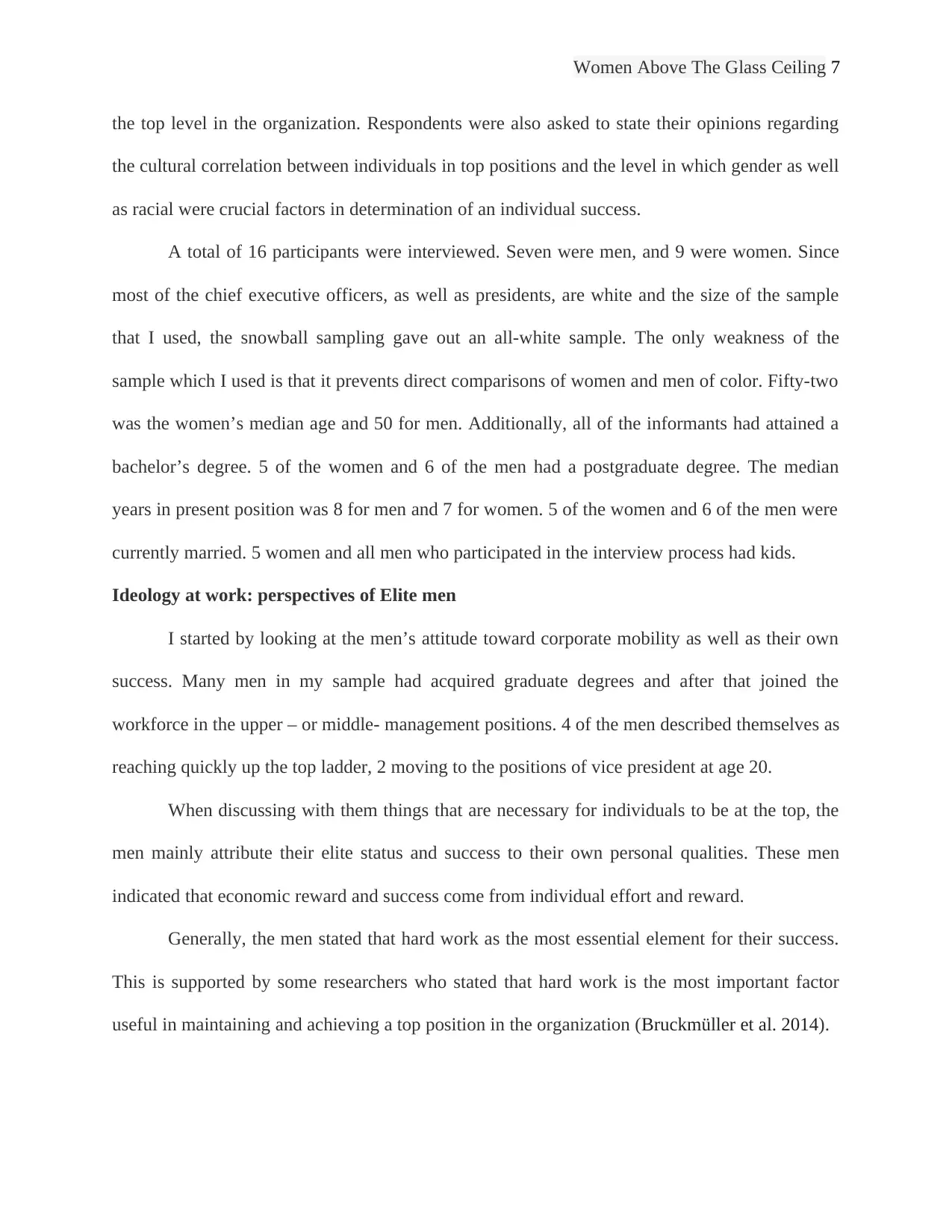
Women Above The Glass Ceiling 7
the top level in the organization. Respondents were also asked to state their opinions regarding
the cultural correlation between individuals in top positions and the level in which gender as well
as racial were crucial factors in determination of an individual success.
A total of 16 participants were interviewed. Seven were men, and 9 were women. Since
most of the chief executive officers, as well as presidents, are white and the size of the sample
that I used, the snowball sampling gave out an all-white sample. The only weakness of the
sample which I used is that it prevents direct comparisons of women and men of color. Fifty-two
was the women’s median age and 50 for men. Additionally, all of the informants had attained a
bachelor’s degree. 5 of the women and 6 of the men had a postgraduate degree. The median
years in present position was 8 for men and 7 for women. 5 of the women and 6 of the men were
currently married. 5 women and all men who participated in the interview process had kids.
Ideology at work: perspectives of Elite men
I started by looking at the men’s attitude toward corporate mobility as well as their own
success. Many men in my sample had acquired graduate degrees and after that joined the
workforce in the upper – or middle- management positions. 4 of the men described themselves as
reaching quickly up the top ladder, 2 moving to the positions of vice president at age 20.
When discussing with them things that are necessary for individuals to be at the top, the
men mainly attribute their elite status and success to their own personal qualities. These men
indicated that economic reward and success come from individual effort and reward.
Generally, the men stated that hard work as the most essential element for their success.
This is supported by some researchers who stated that hard work is the most important factor
useful in maintaining and achieving a top position in the organization (Bruckmüller et al. 2014).
the top level in the organization. Respondents were also asked to state their opinions regarding
the cultural correlation between individuals in top positions and the level in which gender as well
as racial were crucial factors in determination of an individual success.
A total of 16 participants were interviewed. Seven were men, and 9 were women. Since
most of the chief executive officers, as well as presidents, are white and the size of the sample
that I used, the snowball sampling gave out an all-white sample. The only weakness of the
sample which I used is that it prevents direct comparisons of women and men of color. Fifty-two
was the women’s median age and 50 for men. Additionally, all of the informants had attained a
bachelor’s degree. 5 of the women and 6 of the men had a postgraduate degree. The median
years in present position was 8 for men and 7 for women. 5 of the women and 6 of the men were
currently married. 5 women and all men who participated in the interview process had kids.
Ideology at work: perspectives of Elite men
I started by looking at the men’s attitude toward corporate mobility as well as their own
success. Many men in my sample had acquired graduate degrees and after that joined the
workforce in the upper – or middle- management positions. 4 of the men described themselves as
reaching quickly up the top ladder, 2 moving to the positions of vice president at age 20.
When discussing with them things that are necessary for individuals to be at the top, the
men mainly attribute their elite status and success to their own personal qualities. These men
indicated that economic reward and success come from individual effort and reward.
Generally, the men stated that hard work as the most essential element for their success.
This is supported by some researchers who stated that hard work is the most important factor
useful in maintaining and achieving a top position in the organization (Bruckmüller et al. 2014).
Paraphrase This Document
Need a fresh take? Get an instant paraphrase of this document with our AI Paraphraser
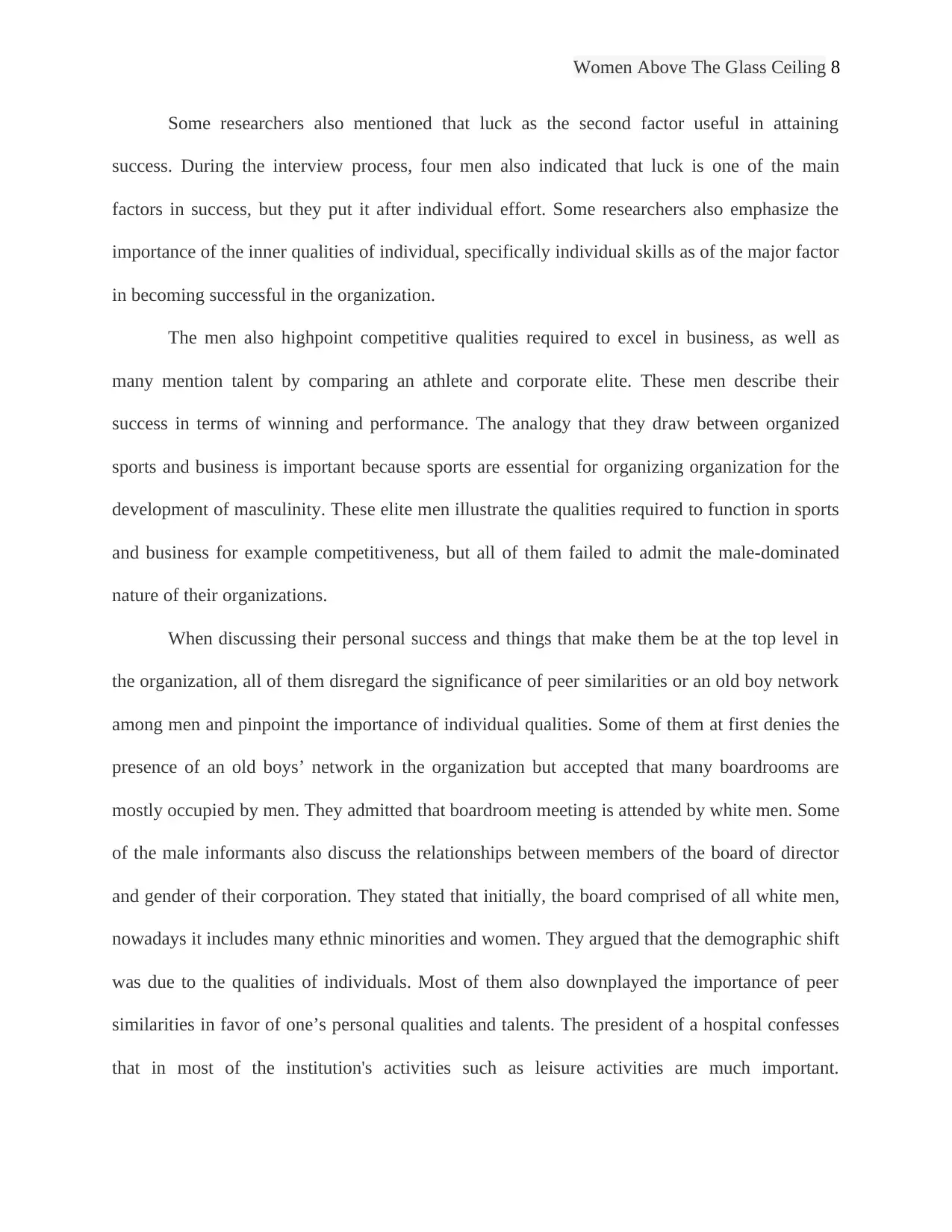
Women Above The Glass Ceiling 8
Some researchers also mentioned that luck as the second factor useful in attaining
success. During the interview process, four men also indicated that luck is one of the main
factors in success, but they put it after individual effort. Some researchers also emphasize the
importance of the inner qualities of individual, specifically individual skills as of the major factor
in becoming successful in the organization.
The men also highpoint competitive qualities required to excel in business, as well as
many mention talent by comparing an athlete and corporate elite. These men describe their
success in terms of winning and performance. The analogy that they draw between organized
sports and business is important because sports are essential for organizing organization for the
development of masculinity. These elite men illustrate the qualities required to function in sports
and business for example competitiveness, but all of them failed to admit the male-dominated
nature of their organizations.
When discussing their personal success and things that make them be at the top level in
the organization, all of them disregard the significance of peer similarities or an old boy network
among men and pinpoint the importance of individual qualities. Some of them at first denies the
presence of an old boys’ network in the organization but accepted that many boardrooms are
mostly occupied by men. They admitted that boardroom meeting is attended by white men. Some
of the male informants also discuss the relationships between members of the board of director
and gender of their corporation. They stated that initially, the board comprised of all white men,
nowadays it includes many ethnic minorities and women. They argued that the demographic shift
was due to the qualities of individuals. Most of them also downplayed the importance of peer
similarities in favor of one’s personal qualities and talents. The president of a hospital confesses
that in most of the institution's activities such as leisure activities are much important.
Some researchers also mentioned that luck as the second factor useful in attaining
success. During the interview process, four men also indicated that luck is one of the main
factors in success, but they put it after individual effort. Some researchers also emphasize the
importance of the inner qualities of individual, specifically individual skills as of the major factor
in becoming successful in the organization.
The men also highpoint competitive qualities required to excel in business, as well as
many mention talent by comparing an athlete and corporate elite. These men describe their
success in terms of winning and performance. The analogy that they draw between organized
sports and business is important because sports are essential for organizing organization for the
development of masculinity. These elite men illustrate the qualities required to function in sports
and business for example competitiveness, but all of them failed to admit the male-dominated
nature of their organizations.
When discussing their personal success and things that make them be at the top level in
the organization, all of them disregard the significance of peer similarities or an old boy network
among men and pinpoint the importance of individual qualities. Some of them at first denies the
presence of an old boys’ network in the organization but accepted that many boardrooms are
mostly occupied by men. They admitted that boardroom meeting is attended by white men. Some
of the male informants also discuss the relationships between members of the board of director
and gender of their corporation. They stated that initially, the board comprised of all white men,
nowadays it includes many ethnic minorities and women. They argued that the demographic shift
was due to the qualities of individuals. Most of them also downplayed the importance of peer
similarities in favor of one’s personal qualities and talents. The president of a hospital confesses
that in most of the institution's activities such as leisure activities are much important.
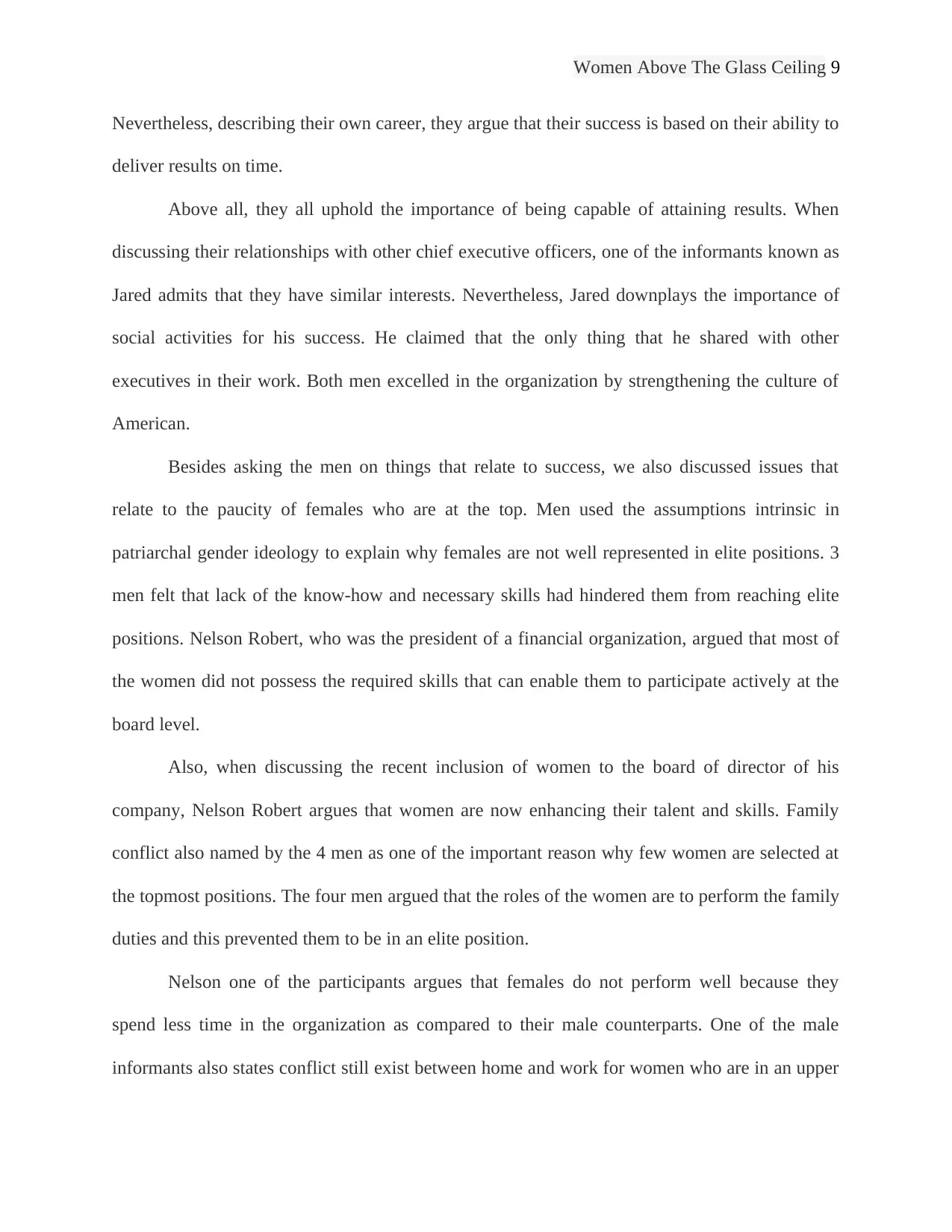
Women Above The Glass Ceiling 9
Nevertheless, describing their own career, they argue that their success is based on their ability to
deliver results on time.
Above all, they all uphold the importance of being capable of attaining results. When
discussing their relationships with other chief executive officers, one of the informants known as
Jared admits that they have similar interests. Nevertheless, Jared downplays the importance of
social activities for his success. He claimed that the only thing that he shared with other
executives in their work. Both men excelled in the organization by strengthening the culture of
American.
Besides asking the men on things that relate to success, we also discussed issues that
relate to the paucity of females who are at the top. Men used the assumptions intrinsic in
patriarchal gender ideology to explain why females are not well represented in elite positions. 3
men felt that lack of the know-how and necessary skills had hindered them from reaching elite
positions. Nelson Robert, who was the president of a financial organization, argued that most of
the women did not possess the required skills that can enable them to participate actively at the
board level.
Also, when discussing the recent inclusion of women to the board of director of his
company, Nelson Robert argues that women are now enhancing their talent and skills. Family
conflict also named by the 4 men as one of the important reason why few women are selected at
the topmost positions. The four men argued that the roles of the women are to perform the family
duties and this prevented them to be in an elite position.
Nelson one of the participants argues that females do not perform well because they
spend less time in the organization as compared to their male counterparts. One of the male
informants also states conflict still exist between home and work for women who are in an upper
Nevertheless, describing their own career, they argue that their success is based on their ability to
deliver results on time.
Above all, they all uphold the importance of being capable of attaining results. When
discussing their relationships with other chief executive officers, one of the informants known as
Jared admits that they have similar interests. Nevertheless, Jared downplays the importance of
social activities for his success. He claimed that the only thing that he shared with other
executives in their work. Both men excelled in the organization by strengthening the culture of
American.
Besides asking the men on things that relate to success, we also discussed issues that
relate to the paucity of females who are at the top. Men used the assumptions intrinsic in
patriarchal gender ideology to explain why females are not well represented in elite positions. 3
men felt that lack of the know-how and necessary skills had hindered them from reaching elite
positions. Nelson Robert, who was the president of a financial organization, argued that most of
the women did not possess the required skills that can enable them to participate actively at the
board level.
Also, when discussing the recent inclusion of women to the board of director of his
company, Nelson Robert argues that women are now enhancing their talent and skills. Family
conflict also named by the 4 men as one of the important reason why few women are selected at
the topmost positions. The four men argued that the roles of the women are to perform the family
duties and this prevented them to be in an elite position.
Nelson one of the participants argues that females do not perform well because they
spend less time in the organization as compared to their male counterparts. One of the male
informants also states conflict still exist between home and work for women who are in an upper
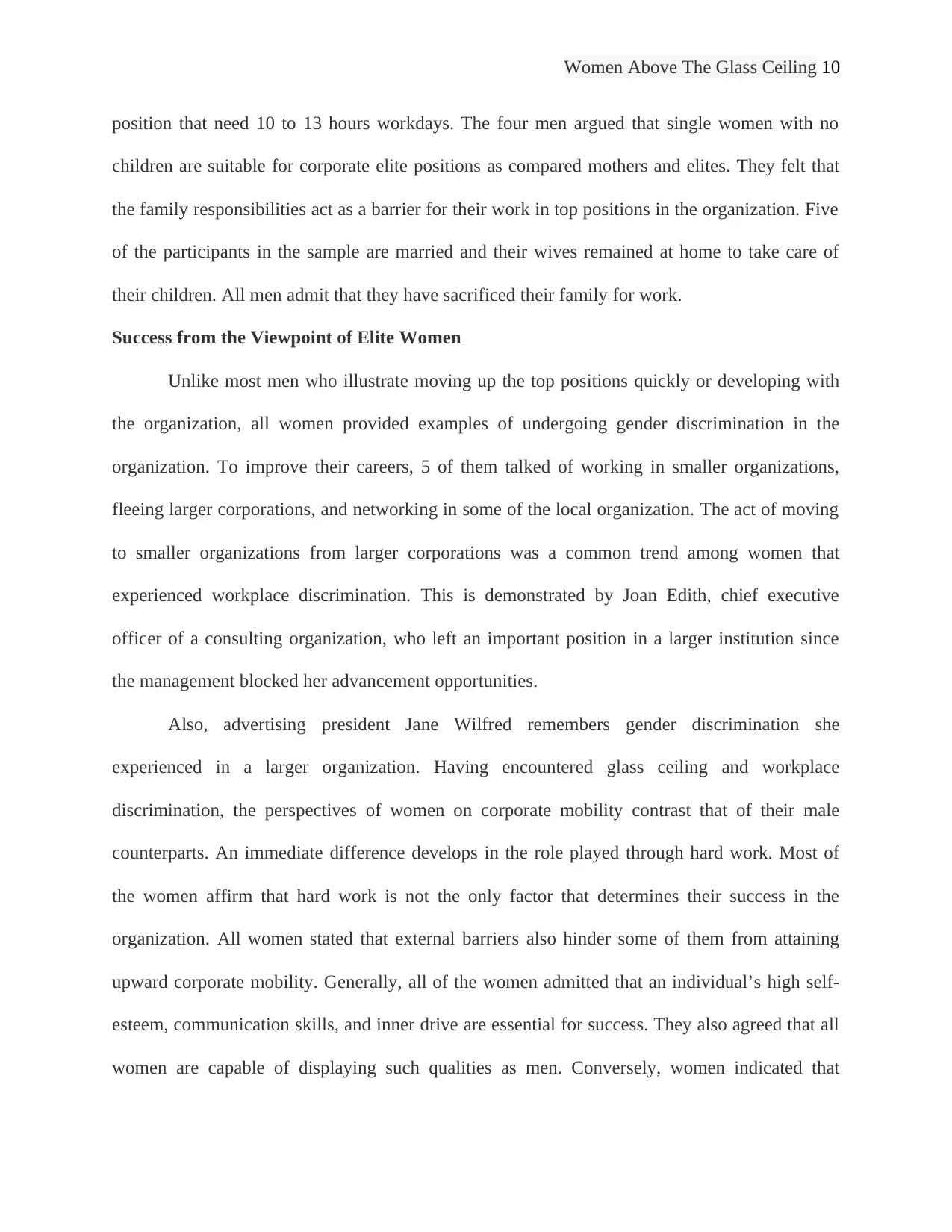
Women Above The Glass Ceiling 10
position that need 10 to 13 hours workdays. The four men argued that single women with no
children are suitable for corporate elite positions as compared mothers and elites. They felt that
the family responsibilities act as a barrier for their work in top positions in the organization. Five
of the participants in the sample are married and their wives remained at home to take care of
their children. All men admit that they have sacrificed their family for work.
Success from the Viewpoint of Elite Women
Unlike most men who illustrate moving up the top positions quickly or developing with
the organization, all women provided examples of undergoing gender discrimination in the
organization. To improve their careers, 5 of them talked of working in smaller organizations,
fleeing larger corporations, and networking in some of the local organization. The act of moving
to smaller organizations from larger corporations was a common trend among women that
experienced workplace discrimination. This is demonstrated by Joan Edith, chief executive
officer of a consulting organization, who left an important position in a larger institution since
the management blocked her advancement opportunities.
Also, advertising president Jane Wilfred remembers gender discrimination she
experienced in a larger organization. Having encountered glass ceiling and workplace
discrimination, the perspectives of women on corporate mobility contrast that of their male
counterparts. An immediate difference develops in the role played through hard work. Most of
the women affirm that hard work is not the only factor that determines their success in the
organization. All women stated that external barriers also hinder some of them from attaining
upward corporate mobility. Generally, all of the women admitted that an individual’s high self-
esteem, communication skills, and inner drive are essential for success. They also agreed that all
women are capable of displaying such qualities as men. Conversely, women indicated that
position that need 10 to 13 hours workdays. The four men argued that single women with no
children are suitable for corporate elite positions as compared mothers and elites. They felt that
the family responsibilities act as a barrier for their work in top positions in the organization. Five
of the participants in the sample are married and their wives remained at home to take care of
their children. All men admit that they have sacrificed their family for work.
Success from the Viewpoint of Elite Women
Unlike most men who illustrate moving up the top positions quickly or developing with
the organization, all women provided examples of undergoing gender discrimination in the
organization. To improve their careers, 5 of them talked of working in smaller organizations,
fleeing larger corporations, and networking in some of the local organization. The act of moving
to smaller organizations from larger corporations was a common trend among women that
experienced workplace discrimination. This is demonstrated by Joan Edith, chief executive
officer of a consulting organization, who left an important position in a larger institution since
the management blocked her advancement opportunities.
Also, advertising president Jane Wilfred remembers gender discrimination she
experienced in a larger organization. Having encountered glass ceiling and workplace
discrimination, the perspectives of women on corporate mobility contrast that of their male
counterparts. An immediate difference develops in the role played through hard work. Most of
the women affirm that hard work is not the only factor that determines their success in the
organization. All women stated that external barriers also hinder some of them from attaining
upward corporate mobility. Generally, all of the women admitted that an individual’s high self-
esteem, communication skills, and inner drive are essential for success. They also agreed that all
women are capable of displaying such qualities as men. Conversely, women indicated that
Secure Best Marks with AI Grader
Need help grading? Try our AI Grader for instant feedback on your assignments.
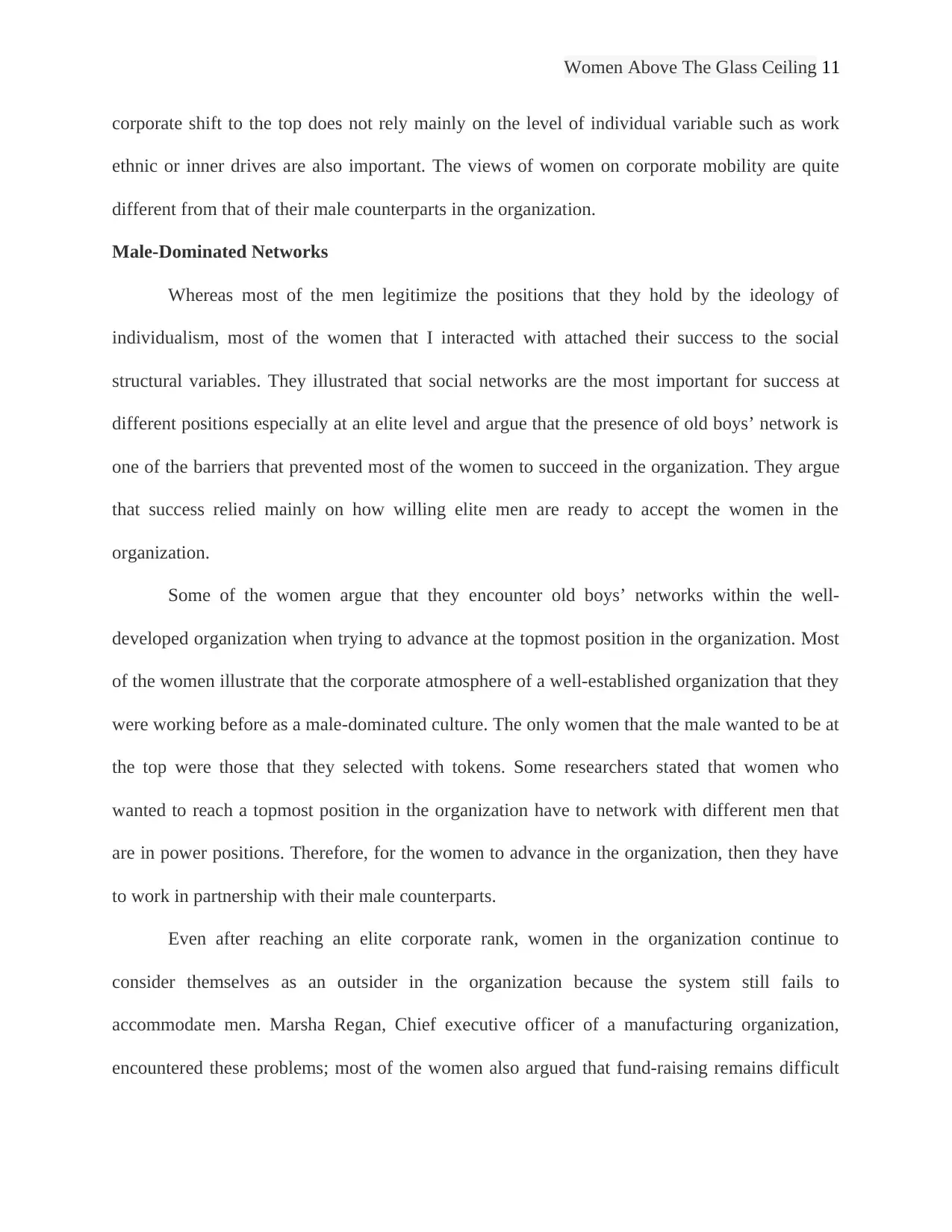
Women Above The Glass Ceiling 11
corporate shift to the top does not rely mainly on the level of individual variable such as work
ethnic or inner drives are also important. The views of women on corporate mobility are quite
different from that of their male counterparts in the organization.
Male-Dominated Networks
Whereas most of the men legitimize the positions that they hold by the ideology of
individualism, most of the women that I interacted with attached their success to the social
structural variables. They illustrated that social networks are the most important for success at
different positions especially at an elite level and argue that the presence of old boys’ network is
one of the barriers that prevented most of the women to succeed in the organization. They argue
that success relied mainly on how willing elite men are ready to accept the women in the
organization.
Some of the women argue that they encounter old boys’ networks within the well-
developed organization when trying to advance at the topmost position in the organization. Most
of the women illustrate that the corporate atmosphere of a well-established organization that they
were working before as a male-dominated culture. The only women that the male wanted to be at
the top were those that they selected with tokens. Some researchers stated that women who
wanted to reach a topmost position in the organization have to network with different men that
are in power positions. Therefore, for the women to advance in the organization, then they have
to work in partnership with their male counterparts.
Even after reaching an elite corporate rank, women in the organization continue to
consider themselves as an outsider in the organization because the system still fails to
accommodate men. Marsha Regan, Chief executive officer of a manufacturing organization,
encountered these problems; most of the women also argued that fund-raising remains difficult
corporate shift to the top does not rely mainly on the level of individual variable such as work
ethnic or inner drives are also important. The views of women on corporate mobility are quite
different from that of their male counterparts in the organization.
Male-Dominated Networks
Whereas most of the men legitimize the positions that they hold by the ideology of
individualism, most of the women that I interacted with attached their success to the social
structural variables. They illustrated that social networks are the most important for success at
different positions especially at an elite level and argue that the presence of old boys’ network is
one of the barriers that prevented most of the women to succeed in the organization. They argue
that success relied mainly on how willing elite men are ready to accept the women in the
organization.
Some of the women argue that they encounter old boys’ networks within the well-
developed organization when trying to advance at the topmost position in the organization. Most
of the women illustrate that the corporate atmosphere of a well-established organization that they
were working before as a male-dominated culture. The only women that the male wanted to be at
the top were those that they selected with tokens. Some researchers stated that women who
wanted to reach a topmost position in the organization have to network with different men that
are in power positions. Therefore, for the women to advance in the organization, then they have
to work in partnership with their male counterparts.
Even after reaching an elite corporate rank, women in the organization continue to
consider themselves as an outsider in the organization because the system still fails to
accommodate men. Marsha Regan, Chief executive officer of a manufacturing organization,
encountered these problems; most of the women also argued that fund-raising remains difficult
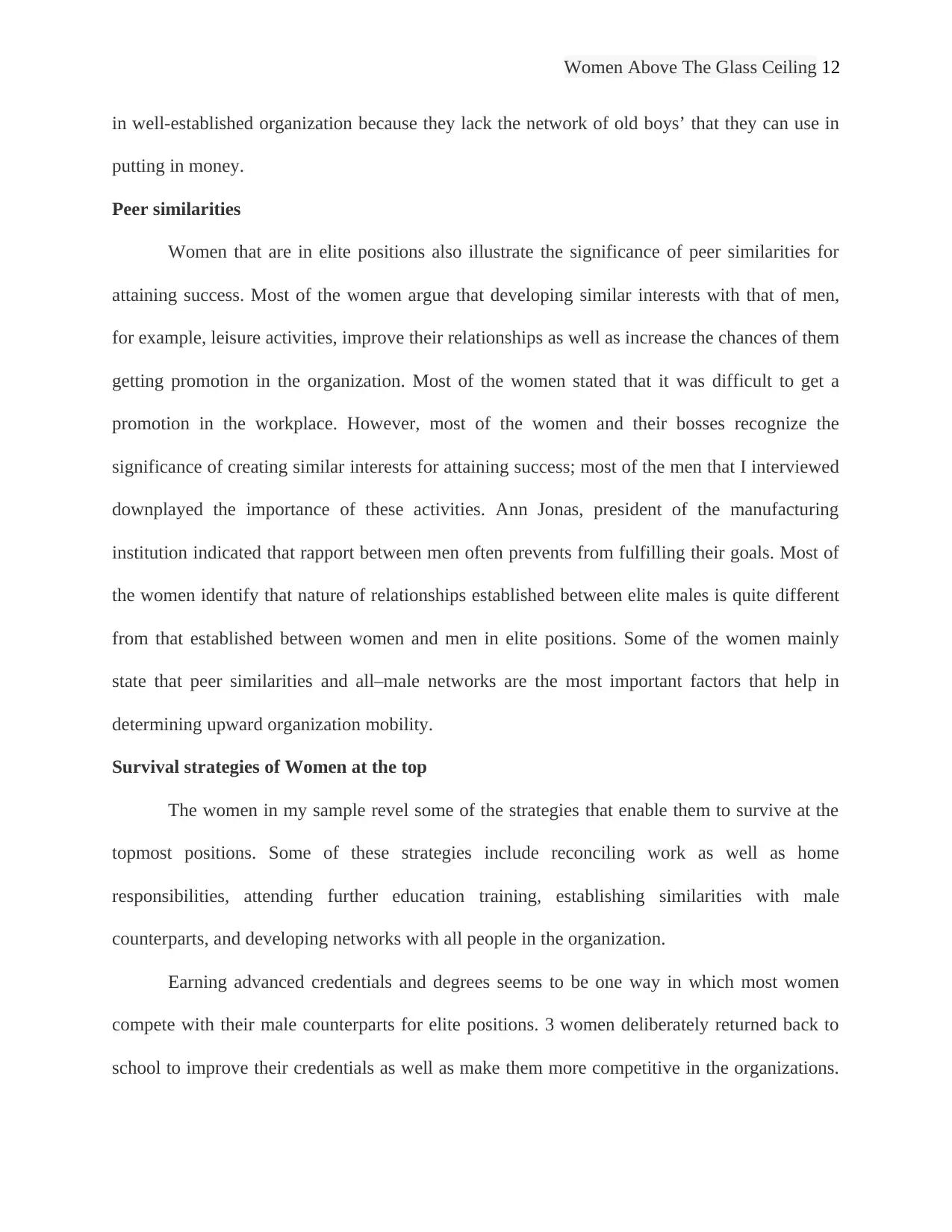
Women Above The Glass Ceiling 12
in well-established organization because they lack the network of old boys’ that they can use in
putting in money.
Peer similarities
Women that are in elite positions also illustrate the significance of peer similarities for
attaining success. Most of the women argue that developing similar interests with that of men,
for example, leisure activities, improve their relationships as well as increase the chances of them
getting promotion in the organization. Most of the women stated that it was difficult to get a
promotion in the workplace. However, most of the women and their bosses recognize the
significance of creating similar interests for attaining success; most of the men that I interviewed
downplayed the importance of these activities. Ann Jonas, president of the manufacturing
institution indicated that rapport between men often prevents from fulfilling their goals. Most of
the women identify that nature of relationships established between elite males is quite different
from that established between women and men in elite positions. Some of the women mainly
state that peer similarities and all–male networks are the most important factors that help in
determining upward organization mobility.
Survival strategies of Women at the top
The women in my sample revel some of the strategies that enable them to survive at the
topmost positions. Some of these strategies include reconciling work as well as home
responsibilities, attending further education training, establishing similarities with male
counterparts, and developing networks with all people in the organization.
Earning advanced credentials and degrees seems to be one way in which most women
compete with their male counterparts for elite positions. 3 women deliberately returned back to
school to improve their credentials as well as make them more competitive in the organizations.
in well-established organization because they lack the network of old boys’ that they can use in
putting in money.
Peer similarities
Women that are in elite positions also illustrate the significance of peer similarities for
attaining success. Most of the women argue that developing similar interests with that of men,
for example, leisure activities, improve their relationships as well as increase the chances of them
getting promotion in the organization. Most of the women stated that it was difficult to get a
promotion in the workplace. However, most of the women and their bosses recognize the
significance of creating similar interests for attaining success; most of the men that I interviewed
downplayed the importance of these activities. Ann Jonas, president of the manufacturing
institution indicated that rapport between men often prevents from fulfilling their goals. Most of
the women identify that nature of relationships established between elite males is quite different
from that established between women and men in elite positions. Some of the women mainly
state that peer similarities and all–male networks are the most important factors that help in
determining upward organization mobility.
Survival strategies of Women at the top
The women in my sample revel some of the strategies that enable them to survive at the
topmost positions. Some of these strategies include reconciling work as well as home
responsibilities, attending further education training, establishing similarities with male
counterparts, and developing networks with all people in the organization.
Earning advanced credentials and degrees seems to be one way in which most women
compete with their male counterparts for elite positions. 3 women deliberately returned back to
school to improve their credentials as well as make them more competitive in the organizations.
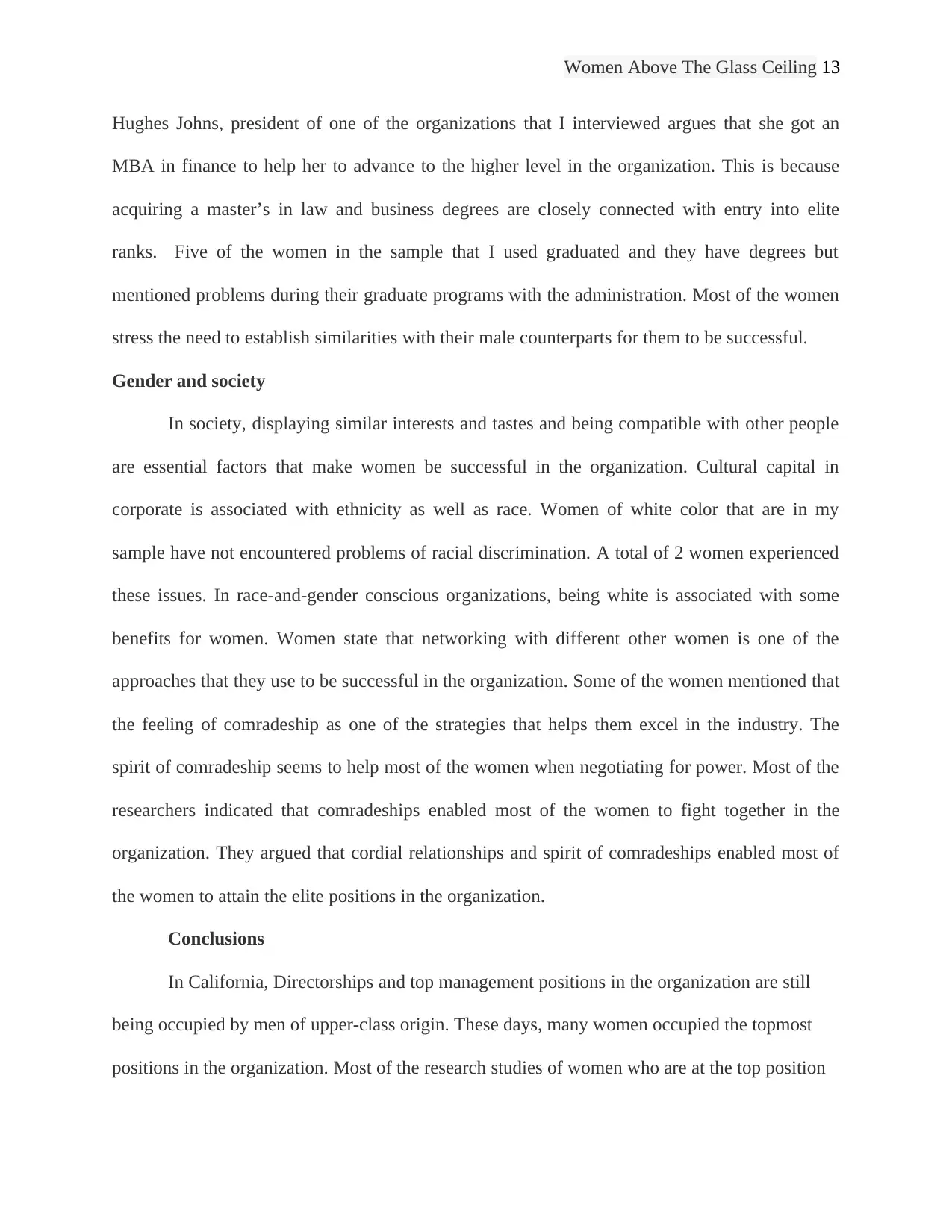
Women Above The Glass Ceiling 13
Hughes Johns, president of one of the organizations that I interviewed argues that she got an
MBA in finance to help her to advance to the higher level in the organization. This is because
acquiring a master’s in law and business degrees are closely connected with entry into elite
ranks. Five of the women in the sample that I used graduated and they have degrees but
mentioned problems during their graduate programs with the administration. Most of the women
stress the need to establish similarities with their male counterparts for them to be successful.
Gender and society
In society, displaying similar interests and tastes and being compatible with other people
are essential factors that make women be successful in the organization. Cultural capital in
corporate is associated with ethnicity as well as race. Women of white color that are in my
sample have not encountered problems of racial discrimination. A total of 2 women experienced
these issues. In race-and-gender conscious organizations, being white is associated with some
benefits for women. Women state that networking with different other women is one of the
approaches that they use to be successful in the organization. Some of the women mentioned that
the feeling of comradeship as one of the strategies that helps them excel in the industry. The
spirit of comradeship seems to help most of the women when negotiating for power. Most of the
researchers indicated that comradeships enabled most of the women to fight together in the
organization. They argued that cordial relationships and spirit of comradeships enabled most of
the women to attain the elite positions in the organization.
Conclusions
In California, Directorships and top management positions in the organization are still
being occupied by men of upper-class origin. These days, many women occupied the topmost
positions in the organization. Most of the research studies of women who are at the top position
Hughes Johns, president of one of the organizations that I interviewed argues that she got an
MBA in finance to help her to advance to the higher level in the organization. This is because
acquiring a master’s in law and business degrees are closely connected with entry into elite
ranks. Five of the women in the sample that I used graduated and they have degrees but
mentioned problems during their graduate programs with the administration. Most of the women
stress the need to establish similarities with their male counterparts for them to be successful.
Gender and society
In society, displaying similar interests and tastes and being compatible with other people
are essential factors that make women be successful in the organization. Cultural capital in
corporate is associated with ethnicity as well as race. Women of white color that are in my
sample have not encountered problems of racial discrimination. A total of 2 women experienced
these issues. In race-and-gender conscious organizations, being white is associated with some
benefits for women. Women state that networking with different other women is one of the
approaches that they use to be successful in the organization. Some of the women mentioned that
the feeling of comradeship as one of the strategies that helps them excel in the industry. The
spirit of comradeship seems to help most of the women when negotiating for power. Most of the
researchers indicated that comradeships enabled most of the women to fight together in the
organization. They argued that cordial relationships and spirit of comradeships enabled most of
the women to attain the elite positions in the organization.
Conclusions
In California, Directorships and top management positions in the organization are still
being occupied by men of upper-class origin. These days, many women occupied the topmost
positions in the organization. Most of the research studies of women who are at the top position
Paraphrase This Document
Need a fresh take? Get an instant paraphrase of this document with our AI Paraphraser
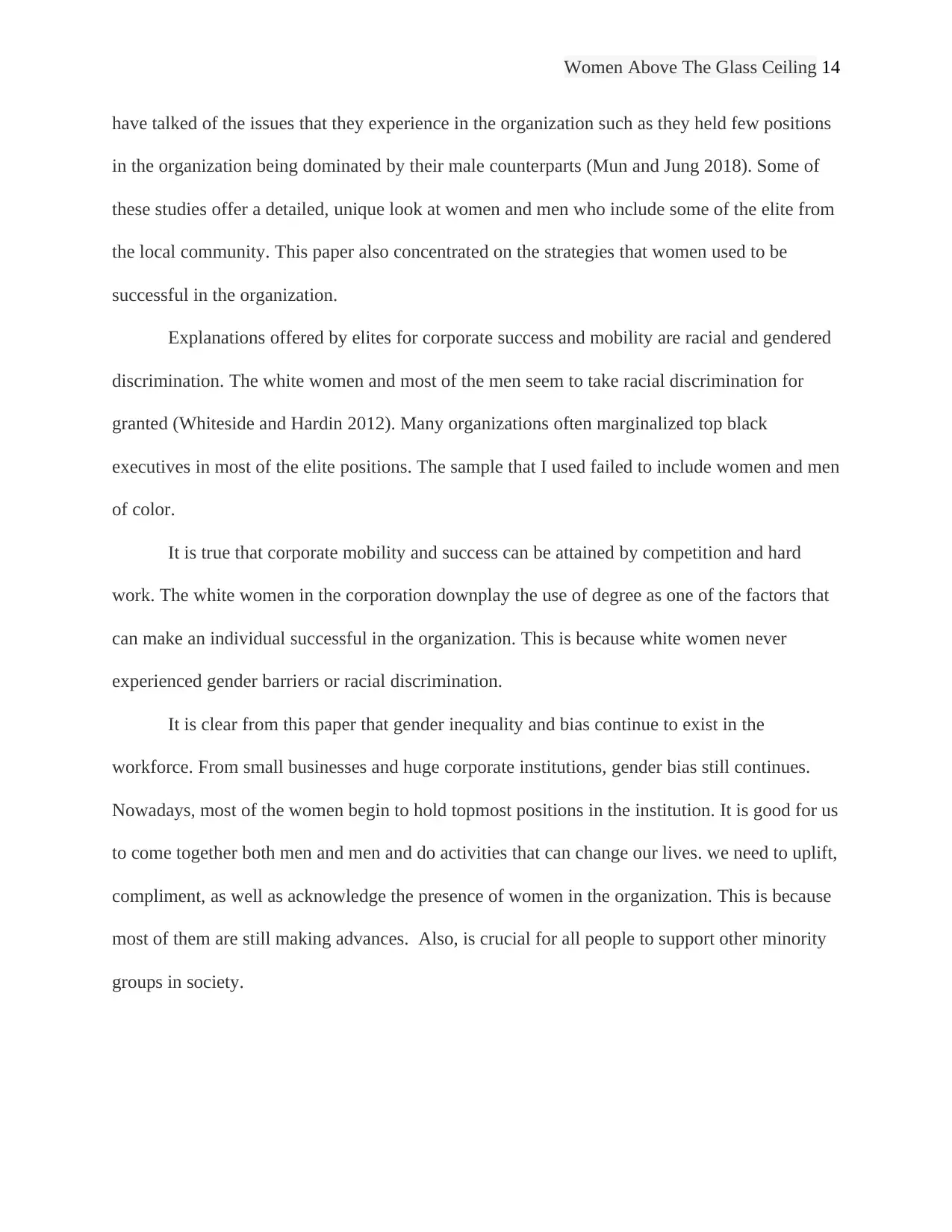
Women Above The Glass Ceiling 14
have talked of the issues that they experience in the organization such as they held few positions
in the organization being dominated by their male counterparts (Mun and Jung 2018). Some of
these studies offer a detailed, unique look at women and men who include some of the elite from
the local community. This paper also concentrated on the strategies that women used to be
successful in the organization.
Explanations offered by elites for corporate success and mobility are racial and gendered
discrimination. The white women and most of the men seem to take racial discrimination for
granted (Whiteside and Hardin 2012). Many organizations often marginalized top black
executives in most of the elite positions. The sample that I used failed to include women and men
of color.
It is true that corporate mobility and success can be attained by competition and hard
work. The white women in the corporation downplay the use of degree as one of the factors that
can make an individual successful in the organization. This is because white women never
experienced gender barriers or racial discrimination.
It is clear from this paper that gender inequality and bias continue to exist in the
workforce. From small businesses and huge corporate institutions, gender bias still continues.
Nowadays, most of the women begin to hold topmost positions in the institution. It is good for us
to come together both men and men and do activities that can change our lives. we need to uplift,
compliment, as well as acknowledge the presence of women in the organization. This is because
most of them are still making advances. Also, is crucial for all people to support other minority
groups in society.
have talked of the issues that they experience in the organization such as they held few positions
in the organization being dominated by their male counterparts (Mun and Jung 2018). Some of
these studies offer a detailed, unique look at women and men who include some of the elite from
the local community. This paper also concentrated on the strategies that women used to be
successful in the organization.
Explanations offered by elites for corporate success and mobility are racial and gendered
discrimination. The white women and most of the men seem to take racial discrimination for
granted (Whiteside and Hardin 2012). Many organizations often marginalized top black
executives in most of the elite positions. The sample that I used failed to include women and men
of color.
It is true that corporate mobility and success can be attained by competition and hard
work. The white women in the corporation downplay the use of degree as one of the factors that
can make an individual successful in the organization. This is because white women never
experienced gender barriers or racial discrimination.
It is clear from this paper that gender inequality and bias continue to exist in the
workforce. From small businesses and huge corporate institutions, gender bias still continues.
Nowadays, most of the women begin to hold topmost positions in the institution. It is good for us
to come together both men and men and do activities that can change our lives. we need to uplift,
compliment, as well as acknowledge the presence of women in the organization. This is because
most of them are still making advances. Also, is crucial for all people to support other minority
groups in society.
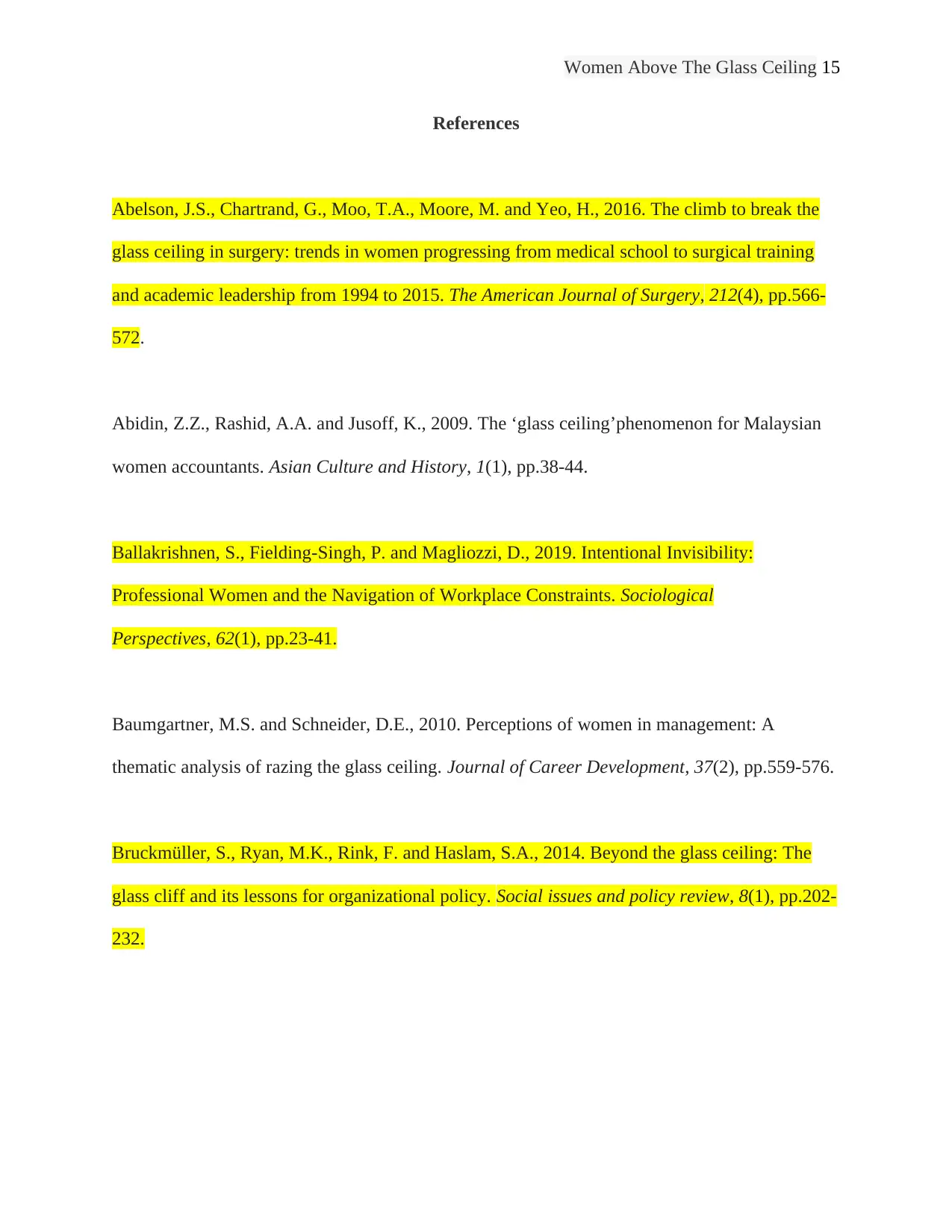
Women Above The Glass Ceiling 15
References
Abelson, J.S., Chartrand, G., Moo, T.A., Moore, M. and Yeo, H., 2016. The climb to break the
glass ceiling in surgery: trends in women progressing from medical school to surgical training
and academic leadership from 1994 to 2015. The American Journal of Surgery, 212(4), pp.566-
572.
Abidin, Z.Z., Rashid, A.A. and Jusoff, K., 2009. The ‘glass ceiling’phenomenon for Malaysian
women accountants. Asian Culture and History, 1(1), pp.38-44.
Ballakrishnen, S., Fielding-Singh, P. and Magliozzi, D., 2019. Intentional Invisibility:
Professional Women and the Navigation of Workplace Constraints. Sociological
Perspectives, 62(1), pp.23-41.
Baumgartner, M.S. and Schneider, D.E., 2010. Perceptions of women in management: A
thematic analysis of razing the glass ceiling. Journal of Career Development, 37(2), pp.559-576.
Bruckmüller, S., Ryan, M.K., Rink, F. and Haslam, S.A., 2014. Beyond the glass ceiling: The
glass cliff and its lessons for organizational policy. Social issues and policy review, 8(1), pp.202-
232.
References
Abelson, J.S., Chartrand, G., Moo, T.A., Moore, M. and Yeo, H., 2016. The climb to break the
glass ceiling in surgery: trends in women progressing from medical school to surgical training
and academic leadership from 1994 to 2015. The American Journal of Surgery, 212(4), pp.566-
572.
Abidin, Z.Z., Rashid, A.A. and Jusoff, K., 2009. The ‘glass ceiling’phenomenon for Malaysian
women accountants. Asian Culture and History, 1(1), pp.38-44.
Ballakrishnen, S., Fielding-Singh, P. and Magliozzi, D., 2019. Intentional Invisibility:
Professional Women and the Navigation of Workplace Constraints. Sociological
Perspectives, 62(1), pp.23-41.
Baumgartner, M.S. and Schneider, D.E., 2010. Perceptions of women in management: A
thematic analysis of razing the glass ceiling. Journal of Career Development, 37(2), pp.559-576.
Bruckmüller, S., Ryan, M.K., Rink, F. and Haslam, S.A., 2014. Beyond the glass ceiling: The
glass cliff and its lessons for organizational policy. Social issues and policy review, 8(1), pp.202-
232.
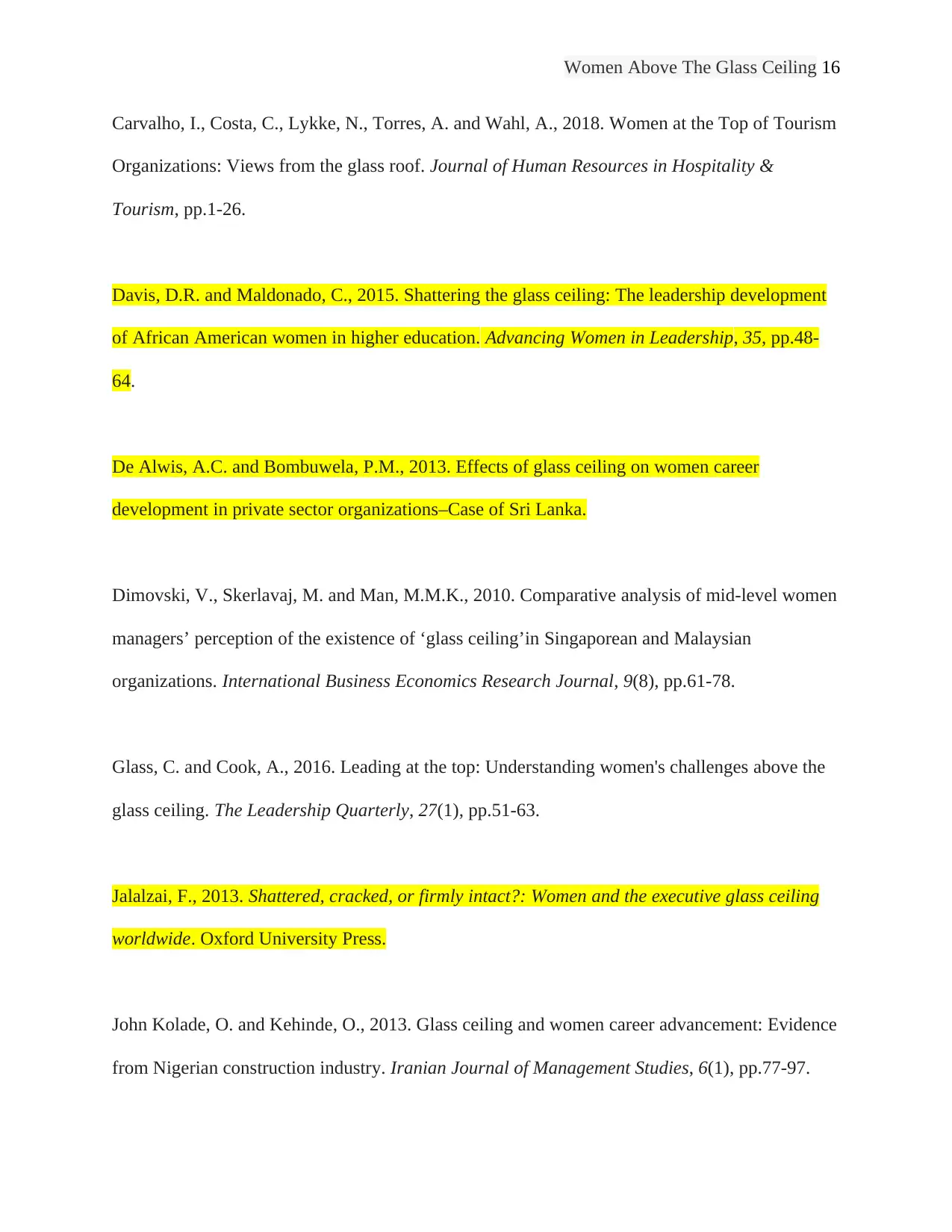
Women Above The Glass Ceiling 16
Carvalho, I., Costa, C., Lykke, N., Torres, A. and Wahl, A., 2018. Women at the Top of Tourism
Organizations: Views from the glass roof. Journal of Human Resources in Hospitality &
Tourism, pp.1-26.
Davis, D.R. and Maldonado, C., 2015. Shattering the glass ceiling: The leadership development
of African American women in higher education. Advancing Women in Leadership, 35, pp.48-
64.
De Alwis, A.C. and Bombuwela, P.M., 2013. Effects of glass ceiling on women career
development in private sector organizations–Case of Sri Lanka.
Dimovski, V., Skerlavaj, M. and Man, M.M.K., 2010. Comparative analysis of mid-level women
managers’ perception of the existence of ‘glass ceiling’in Singaporean and Malaysian
organizations. International Business Economics Research Journal, 9(8), pp.61-78.
Glass, C. and Cook, A., 2016. Leading at the top: Understanding women's challenges above the
glass ceiling. The Leadership Quarterly, 27(1), pp.51-63.
Jalalzai, F., 2013. Shattered, cracked, or firmly intact?: Women and the executive glass ceiling
worldwide. Oxford University Press.
John Kolade, O. and Kehinde, O., 2013. Glass ceiling and women career advancement: Evidence
from Nigerian construction industry. Iranian Journal of Management Studies, 6(1), pp.77-97.
Carvalho, I., Costa, C., Lykke, N., Torres, A. and Wahl, A., 2018. Women at the Top of Tourism
Organizations: Views from the glass roof. Journal of Human Resources in Hospitality &
Tourism, pp.1-26.
Davis, D.R. and Maldonado, C., 2015. Shattering the glass ceiling: The leadership development
of African American women in higher education. Advancing Women in Leadership, 35, pp.48-
64.
De Alwis, A.C. and Bombuwela, P.M., 2013. Effects of glass ceiling on women career
development in private sector organizations–Case of Sri Lanka.
Dimovski, V., Skerlavaj, M. and Man, M.M.K., 2010. Comparative analysis of mid-level women
managers’ perception of the existence of ‘glass ceiling’in Singaporean and Malaysian
organizations. International Business Economics Research Journal, 9(8), pp.61-78.
Glass, C. and Cook, A., 2016. Leading at the top: Understanding women's challenges above the
glass ceiling. The Leadership Quarterly, 27(1), pp.51-63.
Jalalzai, F., 2013. Shattered, cracked, or firmly intact?: Women and the executive glass ceiling
worldwide. Oxford University Press.
John Kolade, O. and Kehinde, O., 2013. Glass ceiling and women career advancement: Evidence
from Nigerian construction industry. Iranian Journal of Management Studies, 6(1), pp.77-97.
Secure Best Marks with AI Grader
Need help grading? Try our AI Grader for instant feedback on your assignments.
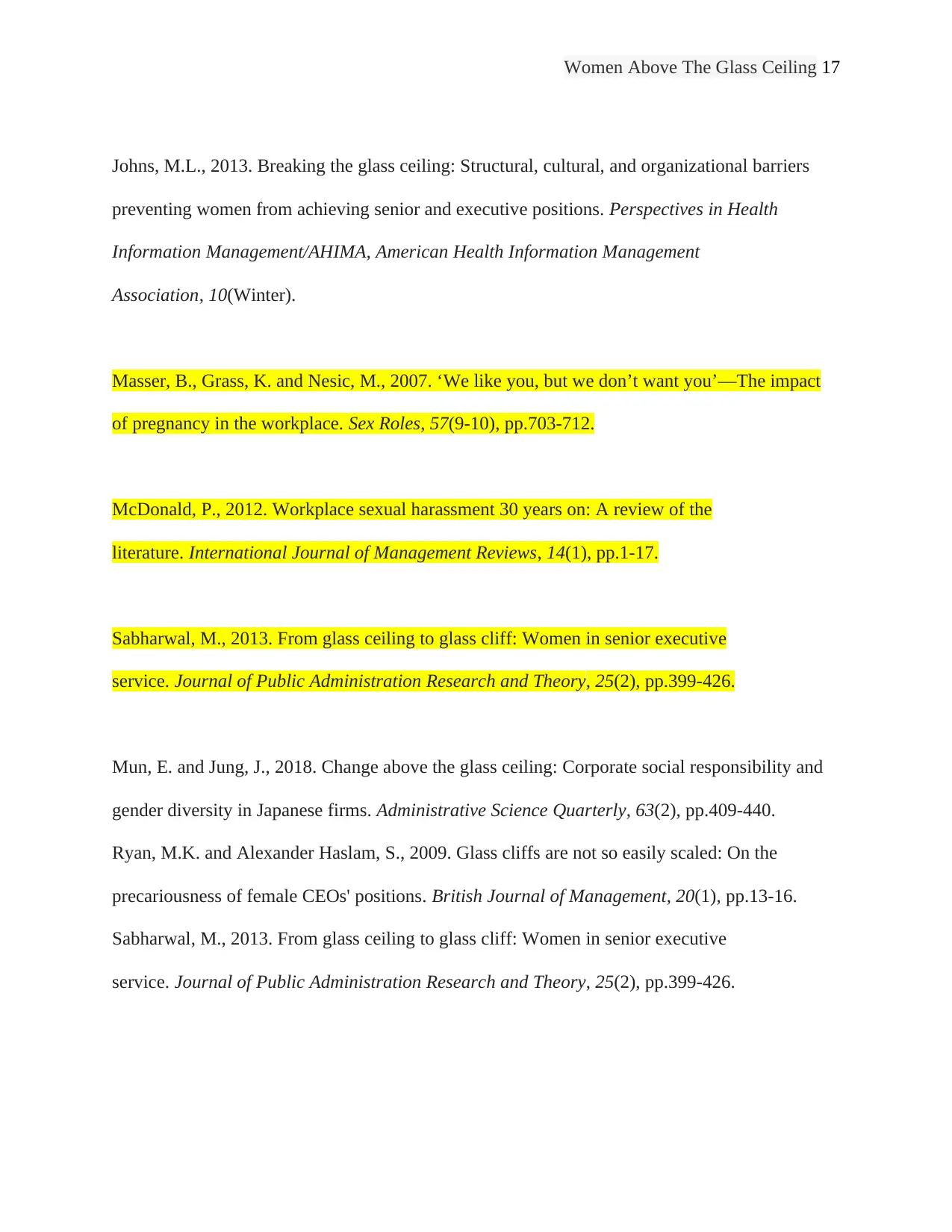
Women Above The Glass Ceiling 17
Johns, M.L., 2013. Breaking the glass ceiling: Structural, cultural, and organizational barriers
preventing women from achieving senior and executive positions. Perspectives in Health
Information Management/AHIMA, American Health Information Management
Association, 10(Winter).
Masser, B., Grass, K. and Nesic, M., 2007. ‘We like you, but we don’t want you’—The impact
of pregnancy in the workplace. Sex Roles, 57(9-10), pp.703-712.
McDonald, P., 2012. Workplace sexual harassment 30 years on: A review of the
literature. International Journal of Management Reviews, 14(1), pp.1-17.
Sabharwal, M., 2013. From glass ceiling to glass cliff: Women in senior executive
service. Journal of Public Administration Research and Theory, 25(2), pp.399-426.
Mun, E. and Jung, J., 2018. Change above the glass ceiling: Corporate social responsibility and
gender diversity in Japanese firms. Administrative Science Quarterly, 63(2), pp.409-440.
Ryan, M.K. and Alexander Haslam, S., 2009. Glass cliffs are not so easily scaled: On the
precariousness of female CEOs' positions. British Journal of Management, 20(1), pp.13-16.
Sabharwal, M., 2013. From glass ceiling to glass cliff: Women in senior executive
service. Journal of Public Administration Research and Theory, 25(2), pp.399-426.
Johns, M.L., 2013. Breaking the glass ceiling: Structural, cultural, and organizational barriers
preventing women from achieving senior and executive positions. Perspectives in Health
Information Management/AHIMA, American Health Information Management
Association, 10(Winter).
Masser, B., Grass, K. and Nesic, M., 2007. ‘We like you, but we don’t want you’—The impact
of pregnancy in the workplace. Sex Roles, 57(9-10), pp.703-712.
McDonald, P., 2012. Workplace sexual harassment 30 years on: A review of the
literature. International Journal of Management Reviews, 14(1), pp.1-17.
Sabharwal, M., 2013. From glass ceiling to glass cliff: Women in senior executive
service. Journal of Public Administration Research and Theory, 25(2), pp.399-426.
Mun, E. and Jung, J., 2018. Change above the glass ceiling: Corporate social responsibility and
gender diversity in Japanese firms. Administrative Science Quarterly, 63(2), pp.409-440.
Ryan, M.K. and Alexander Haslam, S., 2009. Glass cliffs are not so easily scaled: On the
precariousness of female CEOs' positions. British Journal of Management, 20(1), pp.13-16.
Sabharwal, M., 2013. From glass ceiling to glass cliff: Women in senior executive
service. Journal of Public Administration Research and Theory, 25(2), pp.399-426.
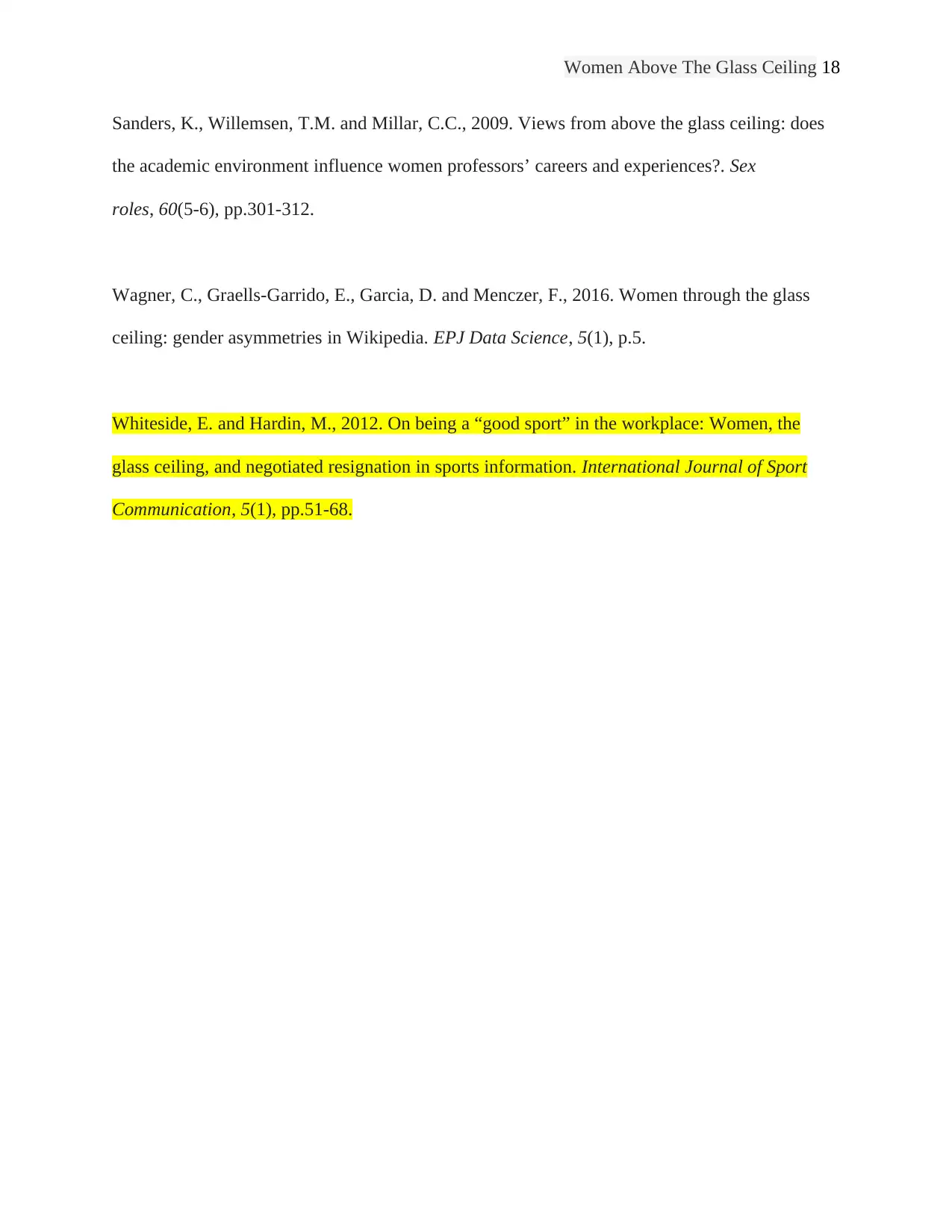
Women Above The Glass Ceiling 18
Sanders, K., Willemsen, T.M. and Millar, C.C., 2009. Views from above the glass ceiling: does
the academic environment influence women professors’ careers and experiences?. Sex
roles, 60(5-6), pp.301-312.
Wagner, C., Graells-Garrido, E., Garcia, D. and Menczer, F., 2016. Women through the glass
ceiling: gender asymmetries in Wikipedia. EPJ Data Science, 5(1), p.5.
Whiteside, E. and Hardin, M., 2012. On being a “good sport” in the workplace: Women, the
glass ceiling, and negotiated resignation in sports information. International Journal of Sport
Communication, 5(1), pp.51-68.
Sanders, K., Willemsen, T.M. and Millar, C.C., 2009. Views from above the glass ceiling: does
the academic environment influence women professors’ careers and experiences?. Sex
roles, 60(5-6), pp.301-312.
Wagner, C., Graells-Garrido, E., Garcia, D. and Menczer, F., 2016. Women through the glass
ceiling: gender asymmetries in Wikipedia. EPJ Data Science, 5(1), p.5.
Whiteside, E. and Hardin, M., 2012. On being a “good sport” in the workplace: Women, the
glass ceiling, and negotiated resignation in sports information. International Journal of Sport
Communication, 5(1), pp.51-68.
1 out of 18
Related Documents
Your All-in-One AI-Powered Toolkit for Academic Success.
+13062052269
info@desklib.com
Available 24*7 on WhatsApp / Email
![[object Object]](/_next/static/media/star-bottom.7253800d.svg)
Unlock your academic potential
© 2024 | Zucol Services PVT LTD | All rights reserved.





